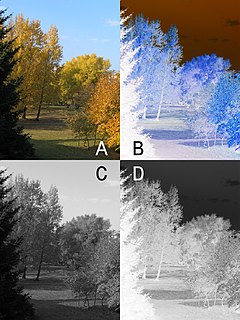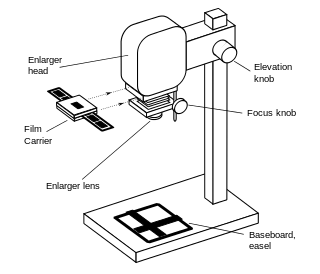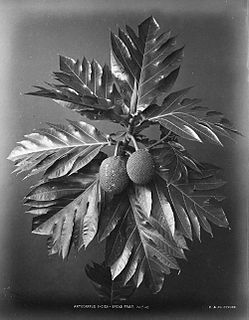
High-dynamic-range imaging (HDRI) is a high dynamic range (HDR) technique used in imaging and photography to reproduce a greater dynamic range of luminosity than is possible with standard digital imaging or photographic techniques. The aim is to present a similar range of luminance to that experienced through the human visual system. The human eye, through adaptation of the iris and other methods, adjusts constantly to adapt to a broad range of luminance present in the environment. The brain continuously interprets this information so that a viewer can see in a wide range of light conditions.

A darkroom is a workshop used by photographers working with photographic film to make prints and carry out other associated tasks. It is a room that can be made completely dark to allow the processing of the light-sensitive photographic materials, including film and photographic paper. Various equipment is used in the darkroom, including an enlarger, baths containing chemicals, and running water.

Color photography is photography that uses media capable of reproducing colors. By contrast, black-and-white (monochrome) photography records only a single channel of luminance (brightness) and uses media capable only of showing shades of gray.
In art, craft, and engineering, masking is the use of materials to protect areas from change, or to focus change on other areas. This can describe either the techniques and materials used to control the development of a work of art by protecting a desired area from change; or a phenomenon that causes a sensation to be concealed from conscious attention.
In photography, bracketing is the general technique of taking several shots of the same subject using different camera settings. Bracketing is useful and often recommended in situations that make it difficult to obtain a satisfactory image with a single shot, especially when a small variation in exposure parameters has a comparatively large effect on the resulting image. Given the time it takes to accomplish multiple shots, it is typically, but not always, used for static subjects. Autobracketing is a feature of many modern cameras. When set, it will automatically take several bracketed shots, rather than the photographer altering the settings by hand between each shot.

A contact print is a photographic image produced from film; sometimes from a film negative, and sometimes from a film positive or paper negative. In a darkroom an exposed and developed piece of photographic film or paper is placed emulsion side down, in contact with a piece of photographic paper, light is briefly shone through the negative or paper and then the paper is developed to reveal the final print.

Photogravure is an intaglio printmaking or photo-mechanical process whereby a copper plate is grained and then coated with a light-sensitive gelatin tissue which had been exposed to a film positive, and then etched, resulting in a high quality intaglio plate that can reproduce detailed continuous tones of a photograph.

Dodging and burning are terms used in photography for a technique used during the printing process to manipulate the exposure of a selected area(s) on a photographic print, deviating from the rest of the image's exposure. In a darkroom print from a film negative, dodging decreases the exposure for areas of the print that the photographer wishes to be lighter, while burning increases the exposure to areas of the print that should be darker.
The Zone System is a photographic technique for determining optimal film exposure and development, formulated by Ansel Adams and Fred Archer. Adams described the Zone System as "[...] not an invention of mine; it is a codification of the principles of sensitometry, worked out by Fred Archer and myself at the Art Center School in Los Angeles, around 1939–40."

Combination printing is the photographic technique of using the negatives of two or more images in conjunction with one another to create a single image.

In photography and cinematography, a multiple exposure is the superimposition of two or more exposures to create a single image, and double exposure has a corresponding meaning in respect of two images. The exposure values may or may not be identical to each other.

Gum bichromate is a 19th-century photographic printing process based on the light sensitivity of dichromates. It is capable of rendering painterly images from photographic negatives. Gum printing is traditionally a multi-layered printing process, but satisfactory results may be obtained from a single pass. Any color can be used for gum printing, so natural-color photographs are also possible by using this technique in layers.

In digital photography, exposing to the right (ETTR) is the technique of adjusting the exposure of an image as high as possible at base ISO to collect the maximum amount of light and thus get the optimum performance out of the digital image sensor.

Photographic film is a strip or sheet of transparent plastic film base coated on one side with a gelatin emulsion containing microscopically small light-sensitive silver halide crystals. The sizes and other characteristics of the crystals determine the sensitivity, contrast and resolution of the film.
In cinematography and photography, flashing is the exposure of the film or digital sensors to uniform light prior to exposing it to the scene. It is used as a method of contrast control to bring out detail in darker areas. This adds a bias to the overall light input recorded by the sensor. When used for artistic effects, it can be used to add a colour cast to shadows without significantly affecting highlights. Flashing is usually described as a percentage of exposure increase to the film's base fog level. While the flash itself is often a neutral color temperature, the flash exposure could be any color: the color of the flash will be imbued disproportionately into the shadows of the image.

Darkroom manipulation is a traditional method of manipulating photographs without the use of computers. Some of the common techniques for darkroom manipulation are dodging, burning, and masking, which though similar conceptually to digital manipulations, involve physical rather than virtual techniques. Darkroom manipulations are those processes used, for example, to remove unwanted areas and change image background, among others. Varying techniques can be used to accomplish the same tasks.
The digital negative is the collective name for methods used by photographers to create negatives on transparency film for the contact printing of alternative photographic techniques. The negatives can also be enlarged using traditional gelatin silver processes, though this is usually reserved for negatives of 4x5" or larger due to quality limitations imposed by printer technology. This set of techniques is separate from the Digital negative (DNG) file format, although this format may be used to create digital negative transparencies.



















